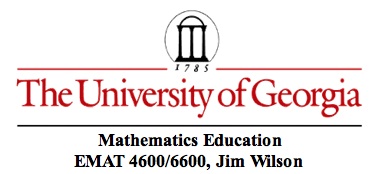

Paula wants to create a smaller, thinner truncated cone. The diameter of the base will be 2 inches and the diameter of the top will be .25 inches. The height will be 7 inches. As before, think about extending the conical figure up to a point and put it Paula's numbers. That is, this pedestal is formed by cutting off a cone with a base having a diameter of .25 inches. The completed cone looks like the following:
I have labeled a few lengths in the figure because they will be useful later.
The idea is to know the values of h, a, and b and then roll the figure out flat.
First, h. h + 7 is the altitude of the whole cone and h is the altitude of the little cone. Now, we have similar triangles and so
So, h = 1 -- that is the altitude of the little cone, and the altitude of the big cone is 8.
By using the Pythagorean relation for the right triangles, we can determine the lengths of the lateral sides of the cones and the pedestal.
or since
a computationally simpler approach would be to use
So
which is approximately 1.008 inches or about 1 1/250 inches.
Then from the large cone
So,
which is approximately 8.062 inches. This is about 8 1/16 incles.
Now, the pattern we want to lay out flat is cut from a circle of radius 8.062 inches and we remove a piece of a circle of radius 1.008 inches (the small cone). Like this:
What is left to determine is how big is the angle from A around to B to get the arc length of
around the base.
In order to determine the angle we use the relation that the arc length is given by
where r is the radius and the angle is in radians.
Therefore,
Multiply by the conversion factor to get degree measure and you have:
In other words Paula's sector from which she will form the truncated cone begins with a circle of radius 8 1/16 inches and uses a sector of approximately 45 degrees. (For constructions with paper or other materials, we would use a slightly larger angle to allow the overlap to provide a seam.)
Now,to make the pattern, draw a circle of radius 8.06 and a smaller circle of radius 1.008. Begin with any radius, and then measure an angle of 45 degrees.Cut out the yellow figure and join the two sides together.
These calculations could also be done with the spread sheet found by clicking HERE and entering the values of 7, .125, and 1 in the appropriate green boxes.